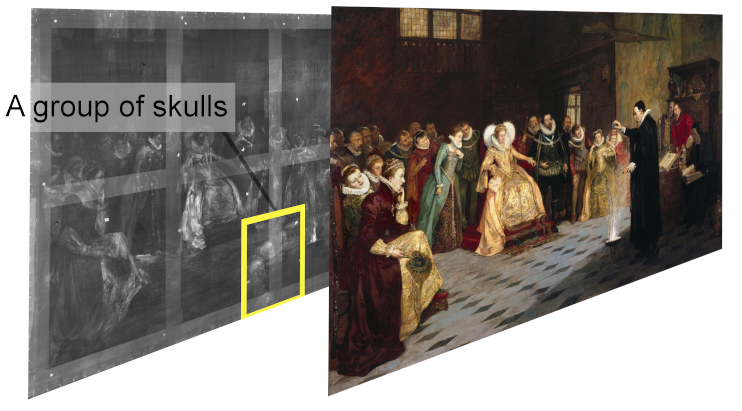Use Case
An Annotation might be specific to a single image or a part of an image rather than the whole Canvas. For instance, you might want to annotate a painting detail that is only visible on a specific image of a multi-spectral set of images.

Furthermore, if you are analyzing a complex multi-layer image you might want to group the Annotations linked to a layer together and keep them embedded.
Implementation Notes
The Web Annotation Model specifies that:
Typically, an Annotation has a single Body, which is a comment or other descriptive resource, and a single Target that the Body is somehow “about”.
Other recipes like Simple Annotation — Tagging or Simplest Annotation add the Annotation to the annotations list of the Canvas targetting the id of the Canvas itself.
In this example, we will write the Annotation as part of the content resources associated with the Canvas adding an Annotation Page with an Annotation inside the annotations list of content resources.
This is the preferred solution rather than adding the Annotation in the annotations field of the Canvas. Doing so, when the client consumes the Annotation all the relevant information to ensure that the Annotation is targeting the intended region is easily accessible.
Some visualizers might choose to render only the Annotation of the active content resource or to allow to group the Annotations based on the content resource they are targeting.
For annotating a part of the image the Annotation will target a SpecificResource resource with an ImageAPI selector specifying the region of interest including the size of the image.
In this recipe we are targeting the ImageApiService but it is also valid to target the Content Resource identifier and this is the only option if you don’t have a IIIF service associated with the image.
Restrictions
When the max image size might vary depending on the image server configurations, to ensure that the Annotation targets the intended region of the image, the ImageAPI selector should provide the size attribute with the width and height of the image in the form w,h.
Example
The example is based on the recipe Multiple Choice of Images in a Single View (Canvas). In this case, we want to annotate the skulls on the floor that are visible only on the X-ray image. Within the content resource annotations attribute we create an Annotation Page with an Annotation. We want to tag only a portion of the image and thus the motivation of the Annotation must be “tagging”. The body of the Annotation must be a TextualBody — with a format of text/plain — that contains the text of our Annotation. The target of the Annotation is a SpecificResource with source assigned to the id of the Service used for serving the image to be annotated. The region of interest is specified in the selector arttribute that is an ImageApiSelector with region attribute assigned to the region of interest (810,900,260,30 in this case) and size assigned to the maximum size of the image available at the moment of the annotation.
Credit: John Dee performing an experiment before Queen Elizabeth I. Oil painting by Henry Gillard Glindoni. Credit: Wellcome Collection. Attribution-NonCommercial 4.0 International (CC BY-NC 4.0)
Related Recipes
- Multiple Choice of Images in a Single View (Canvas) for the original example without annotations.
- Simple Annotation — Tagging for an Annotation using a fragment selector
- Full Canvas annotation for a simple annotation of the whole Canvas.
- Annotation with a Non-Rectangular Polygon for an Annotation using an SVG selector
- Simplest Manifest - Image
- Composition from multiple images another approach for building multi-layer Canvases
- Embedded or Referenced Annotations